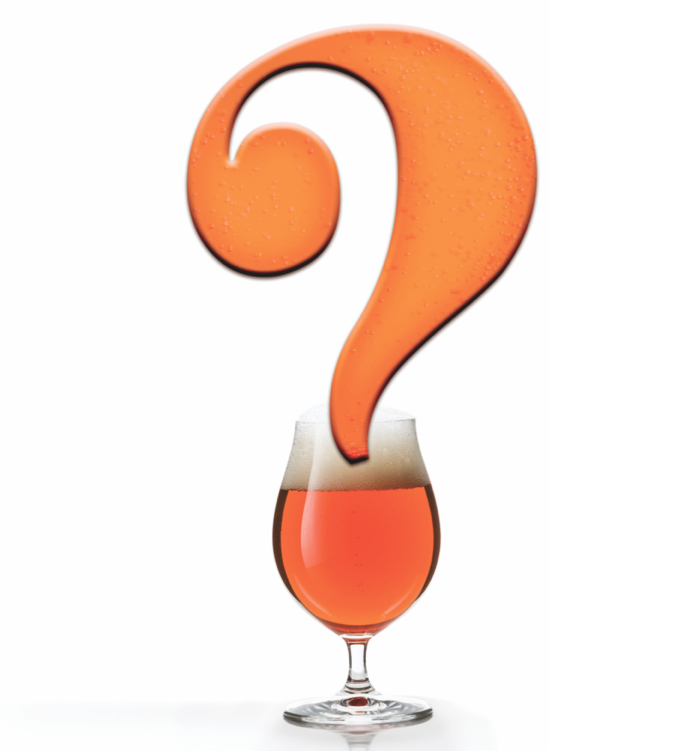Brewing a Brut IPA
Q: I have been reading about “Brut IPAs” and am curious what these beers are, and how they are being brewed. Any information would be great!
— Ben Bauer • Gilroy, California
A: Brut IPAs are the current IPA rage blazing across the nation. Kim Sturvandt at Social Kitchen & Brewery in San Francisco is credited with being the first brewer to create this type of IPA at the end of 2017. Since that time, this beer style has spread to other Bay Area brewers and beyond to other brewing regions of the US. The idea of brut IPA began as a way of drying out bigger IPAs to improve balance and to allow late hops the ability to shine. The key to this style is amyloglucosidase, an exogenous brewing enzyme used for a variety of applications.
Amyloglucosidase is a mouthful, so most brewers simply call it AMG or Amylo (or the older term Convertase), taken from the trade name Amylo 300 used by many brewers to brew these brut brutes. As long-time readers of my column know, I don’t write much about styles and prefer delving into the technical side of brewing, but I cannot ignore opining a bit about this style.
When I first heard of this type of beer I concocted a mental pint that was dry, bitter, very bubbly, and hoppy. To my mental palate one word comes to mind . . . unbalanced. There is something about dry, highly aromatic, and bitter IPAs that seems out of kilter to my palate, and the exceptionally high carbonation in my mental pint accentuated the unbalance. Call me odd, I like an IPA with some malt balance. This is all preference stuff and the reason I avoid these topics when at all possible is because we all have our personal preferences. The bottom line was my mental pint stayed full for some time; after all, I live in Missouri and had no reference when first reading about this beer.
But when I tasted an actual brut IPA I experienced something quite different, and I really liked what I tasted. Aromatic and hoppy, but not unbalanced by bitterness like many of the West Coast IPAs brewed during the race for the most extreme bitter face. And dry and bubbly, but not dry like many Champagnes, which is of course where Kim got his inspiration for the name.
To my palate, the very low finish gravity boosts fruitiness by pairing back sweet, malt notes that can make for a cloying finish that competes with hop and yeast esters, and leaving a less cluttered canvas where the other beer components can shine. The dryness does not give way to the astringent notes aggravated by extremely high carbonation that were present in my mental pint. I think what is being revealed here is how biased folks, at least one, can become by the name of a beer or a beer style.
Interested in brewing a brut IPA? Keep on reading. The common feature of this style is the use of AMG. This enzyme hyrdrolyzes the alpha 1-6 bond found in branched dextrins left over from the action of alpha and beta amylase on amylopectin, the predominate type of starch found in all of the grains used in brewing. AMG also hydrolyzes alpha 1-4 bonds from the end of starch chains to yield glucose. This all means that if AMG is allowed enough time to do its thing, the final gravity of beers treated with AMG will be quite low. Because the density of ethanol is less than water, very dry beers can have a specific gravity less than 1.000, or an apparent extract less than 0 °Plato, which gives way to the expression “finishing negative.”
The first AMG beer to make a huge splash was Miller Lite in 1973, but this beer was not the first of its type. Dr. Joe Owades pioneered this work at the Rheingold Brewing Company in the late 1960s and his new type of beer was originally launched as Gablinger’s Diet Beer, which did not do so well. He passed along his idea to Peter Hand Brewing where Meister Bräu Lite was born. Miller acquired the brand in 1972 and relaunched it as simply “Lite” in 1973. And for about the last 40 years, the enzyme AMG has been synonymous with American-style light lagers with their bone dry character and low-level flavors.
There are really two ways to use AMG in brewing; it can be added to wort or mash in the brewhouse or it can be added to the fermenter during fermentation, and both methods have their merits. The most cautious approach is to add AMG to the mash where it becomes part of the enzyme party and works along with the activity of alpha and beta amylase. I consider this approach cautious because extended mash rests and/or increased enzyme doses are required to end up with a negative final gravity. In fact, many craft brewers have used AMG for years to slightly reduce finish gravities and have not made a big fuss about this technique because not all breweries are keen on revealing every detail about how things are done.
The take home message here is that adding AMG to the mash is a good way to give this enzyme a trial without totally drying out your beer. But if you really want to see how dry you can go, the key is adding AMG to the fermenter. Although the temperature during fermentation is well below AMG’s peak temperature activity, the time of fermentation is rather long in comparison to the time of mashing. Another key difference is that the heavy lifting of starch degradation is completed during mashing and AMG only acts upon the branched starch bits, the so-called limit dextrins, that alpha and beta amylase cannot hydrolyze in the mash, and this is a plus for the kinetics of the reaction. Most fermentations will go negative when AMG is added to the fermenter, and if they don’t, they likely will . . . in the bottle.
Unless you are looking to produce bottle bombs, you need to allow enzymatic and fermentation activity to completely cease prior to bottling. And this brings up another dilemma; big beers may be pushing the alcohol tolerance of yeast, so the enzyme may produce fermentables that are not metabolized by yeast, which may add sweetness or become a food source for spoilage organisms. Brewers who like to harvest and re-pitch yeast from one fermentation to another need to be mindful that the yeast crop will contain active amyloglucosidase.
Yet a few more reasons why using AMG in the mash is a more conservative approach. Not all brewers are conservative, so if you are plowing ahead with AMG in the fermenter, you need to consider all of these potential issues. AMG produces glucose from limit dextrins. If you present yeast with a plate of fermentable sugars that includes glucose, maltose, and maltotriose, the glucose is preferentially gobbled up and the occasional result of this carbohydrate party are left over molecules of maltose and maltotriose; in other words we have a hanging fermentation that does not completely finish. But if the yeast are first presented with maltose and maltotriose and then presented with glucose afterwards, fermentations tend to be more consistent and are less likely to stall.
So here is the take home message about AMG in the fermenter; add it after the peak fermentation is complete, but before yeast flocculation. This same approach is used by brewers who are looking to produce very high-alcohol beers using fed fermentation methods, which helps the yeast finish fermentation. Some of these brews are carbonated to very high, Champagne-like levels and others have more normal carbonation levels. The commonality is that brut IPAs are all dried by the artful use of AMG and that is what makes this style different. So go get your brut on!
Several brewing suppliers carry AMG and they all have similar properties, but not all have the same enzyme concentration and it is important to verify suggested usage rates. In general, these products work well in the mash at temperatures ranging from 140–150 °F (60–65 ˚C) at a usage rate of 0.004–0.012 oz./lb. (0.25–1.25 mL per kilogram) of malt (dosage depends on supplier). AMG does work best in conjunction with alpha amylase, or after alpha amylase has had sufficient time to reduce the size of amylopectin molecules, and time of addition is one of the levers available to the brewer for process control. Alternatively, AMG can be added in fermentation at the rate of 0.0013 oz./gal.–0.005 oz./gal. (0.01–0.04 mL per liter) of beer. Check online for sources of AMG or ask your local homebrewing store to buy a liter and sell in smaller quantities. AMG solutions typically retain over 95% of their activity after a year of storage at temperatures below 65 °F (18 °C); refrigerated storage is advised.



